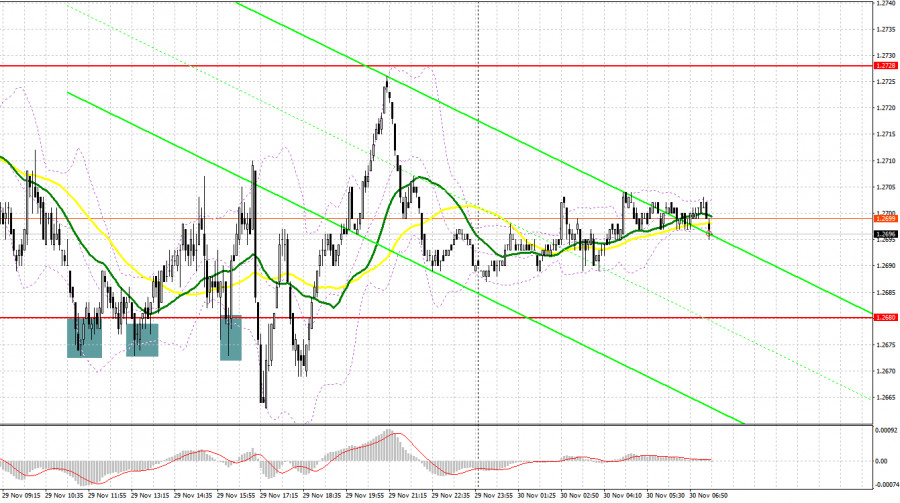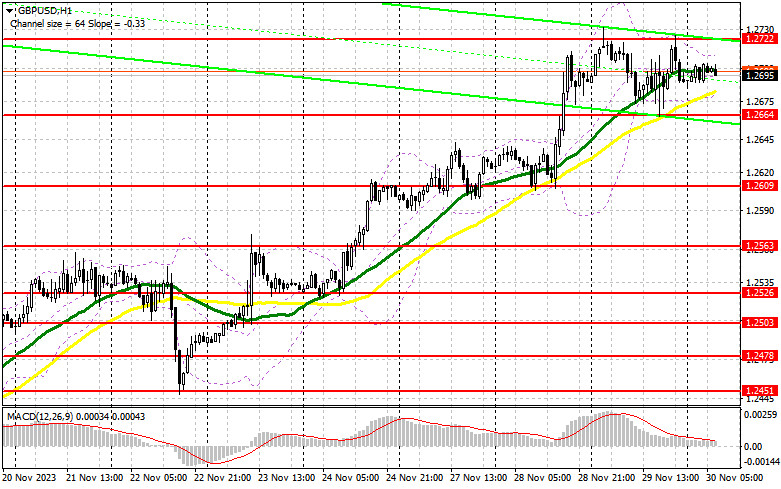
Yesterday, the pair formed several entry signals. Let's have a look at what happened on the 5-minute chart. In my morning review, I mentioned the level of 1.2680 as a possible entry point. A decline and false breakout near this mark produced a buy signal, but the pair did not actively rise in the first half of the day. During the US session, despite the strong US reports, safeguarding the support at 1.2680 generated several buy signals. But eventually one of them sent the pair up by more than 30 pips.

For long positions on GBP/USD:
Taking advantage of the upward revision on the growth in US Q3-2023 GDP data, as well as the downward movement of GBP/USD, the bulls quickly stopped the bears' attempts to build any downward correction. In the absence of UK reports on Thursday, and since we only have the speech of Bank of England MPC member Megan Green, the pair may continue to trade in the sideways channel, which was established this week. In case GBP/USD falls while bears try to build a downward correction, I plan to act around the nearest support at 1.2664. A decline and false breakout on this mark will provide an entry point for long positions aimed at developing the upward trend and retest the resistance at 1.2722, established yesterday. A breakout and consolidation above this range is unlikely to happen in the first half of the day, but if it happens, I will go long in anticipation of testing the new monthly high of 1.2761. The furthest target will be the 1.2797 area, where I plan to take profits. If the pair falls and there is no buying activity at 1.2664, the pressure on the pair will definitely increase, which will lead to a larger downward correction. In this case, only a false breakout near the next support at 1.2609 will signal opening long positions. I plan to buy GBP/USD immediately on a rebound from 1.2563, aiming for an intraday correction of 30-35 pips.
For short positions on GBP/USD:
Sellers are trying, but no one is particularly interested in opening short positions even when the pair is trading at highs. Yesterday, Bank of England Governor Andrew Bailey's comments supported the British pound. In the first half of the day, I will act after defending the monthly high of 1.2722. Forming a false breakout at that mark will give bears a chance to move the price down to the support at 1.2664. Above this level, we have the moving averages that favor the bulls, where I expect them to be active. Therefore, only a breakout and a retest from below will deal a more serious blow to the buyers' positions, leading to the removal of stop orders and opening the way to 1.2609. The further target will be the 1.2563 area, where I will take profits. If GBP/USD rises and there is no activity at 1.2722 in the first half of the day, the uptrend will continue. In such a case, I will postpone sales until the price performs a false breakout at 1.2761. If there is no downward movement there, I will sell GBP/USD immediately on a rebound from 1.2797, considering a downward correction of 30-35 pips within the day.

COT report:
The Commitments of Traders (COT) report for November 21 showed a decrease in both long and short positions. The pound was in demand throughout last week, as the statements of the Bank of England officials that the central bank, if not to continue raising interest rates, at least will keep them at the current highs for quite a long period of time, had boosted the pair. The minutes of the Federal Reserve's November meeting, which were hawkish in nature, had no effect on market sentiment. This week, several Fed officials are scheduled to speak, which may help the dollar to compensate for the recent losses, but the US central bank officials should make the same promises as the BoE officials did. The latest COT report indicates that non-commercial long positions decreased by 9,497 to 43,300, while non-commercial short positions were down by 11,129 to 69,398. As a result, the spread between long and short positions increased by 2107. The weekly closing price rose to 1.2543, up from the previous value of 1.2503.
Indicator signals:
Moving Averages
The instrument is trading above the 30 and 50-day moving averages. It indicates that GBP/USD is likely to rise further.
Please note that the time period and levels of the moving averages are analyzed only for the H1 chart, which differs from the general definition of the classic daily moving averages on the D1 chart.
Bollinger Bands
If GBP/USD declines, the indicator's lower border near 1.2675 will serve as support.
Description of indicators:
• A moving average of a 50-day period determines the current trend by smoothing volatility and noise; marked in yellow on the chart;
• A moving average of a 30-day period determines the current trend by smoothing volatility and noise; marked in green on the chart;
• MACD Indicator (Moving Average Convergence/Divergence) Fast EMA with a 12-day period; Slow EMA with a 26-day period. SMA with a 9-day period;
• Bollinger Bands: 20-day period;
• Non-commercial traders are speculators such as individual traders, hedge funds, and large institutions who use the futures market for speculative purposes and meet certain requirements;
• Long non-commercial positions represent the total number of long positions opened by non-commercial traders;
• Short non-commercial positions represent the total number of short positions opened by non-commercial traders;
• The non-commercial net position is the difference between short and long positions of non-commercial traders.